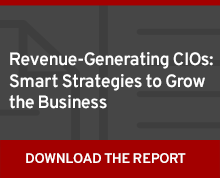When it comes to IT organizations pleasing the CEO, nothing speaks like cold hard cash – as in creating top-line profit. In a new Harvard Business Review Analytic Services report, "Revenue-Generating CIOs: Smart Strategies to Grow the Business," you can explore lessons learned from 15 CIOs who are successfully driving revenue for their business. While not all of them have similar prior experiences, such as running a P&L or a startup, these CIOs all share a common skill set.

Leading CIOs drive revenue through activities including digital products, such as reselling data; digital business operations, such as enrolling online customers faster; software sales, which often involves bringing in-house tools to market; and reselling IT services.
The report finds that CIOs who know how to make it rain do four things particularly well.
1. Adopt a product mentality
Revenue-generating CIOs teach their teams that they’re not just building projects: They’re responsible for every aspect of product development and delivery. As Mojgan Lefebvre, CIO of the Global Specialty business unit at Liberty Mutual says, “A project has a beginning and an end. The project ends when we put the product in users’ hands.” Her group (working in a multifunctional, agile team) owns software products from the ideation phase right through service and support for customers. Liberty Mutual also uses design thinking techniques to focus teams on customer experience.
2. Increase the speed of development and delivery
For these revenue-driving CIOs, faster development and delivery becomes essential. Thus many of them have embraced the idea of minimum viable product and adopted agile and DevOps methods that emphasize speed and collaboration. Some companies also use separate innovation centers to speed development of new ideas. For example, CVS Health’s Boston innovation center lets IT and digital business teams experiment with customer-facing ideas such as CVS Pay, notes executive vice president and CIO Stephen Gold.
3. Hire, develop, and retain exceptional talent
The way these CIOs hire and retain talent has changed, given their use of agile, cross-functional teams that include IT and line-of-business experts. Often, this means people who can wear a greater number of technical hats, focusing on areas from mobility to user experience. A CIO recruiting such talent must sell the team’s technical chops, the focus on commercialization, and the company mission. Then, they need to create a rewarding environment. “I always tell people, I guarantee you, after you’ve spent enough time with us and learned from our disciplines, you’ll be doing stuff you never thought you would be able to do,” says CVS Health's Gold.
4. Collaborate deeply with business owners and digital officers
Companies need clear leadership for digital transformation, which often means a CIO working alongside a chief digital officer and other business leaders in partnership. “The idea that hiring a CDO means the CIO isn’t doing his or her job is a false assumption,” the report states. GE, for example, has a CIO and CDO at the corporate level, as well as in the lines of business. At Union Pacific, CIO Lynden Tennison mentions his standing “as an unabashed capitalist” as key to his success driving new technology subsidiaries – and as a revenue-generating CIO. “I love competing in the marketplace.”
Download the full HBR report now to get more wisdom and advice from 15 innovative CIOs.






